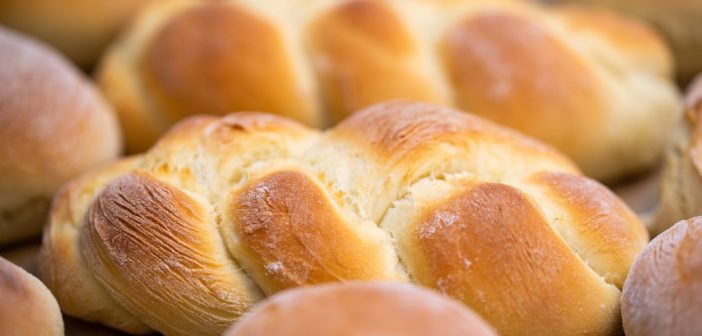Flour, water, yeast. Or sometimes just flour and water. Considering how important bread is to culinary cultures around the world, its basic ingredients are beguilingly simple.
What’s most incredible about bread is how this basic template has given rise to so much variety and invention. Flatbreads and light, airy loafs, sweet and savoury, crusty and soft, white and brown – even these differences don’t begin to capture the countless ingredients and techniques that go into bread making, a craft honed over millennia.
It’s also hard to overstate the cultural importance of bread. In European and near Eastern traditions, the phrase ‘breaking bread’ is shorthand for sharing a meal with someone. The suggestion being that, without bread, there is no meal. It’s also a phrase that carries meanings of familiarity, communality, sharing with others. To eat is to socialise, and bread is a symbol of bringing people together.
So when you are planning catering for your next event, don’t overlook the importance of bread. Not only is it arguably the most flexible of food staples, serving up quality breads will take the enjoyment of your guests to another level.
After all, what beats the smell and taste of freshly baked, still warm bread? Even the most basic sandwich, or a simple cheeseboard and selection of dips, can be elevated to the level of haut cuisine by a top quality loaf.
As noted, it would be a mammoth task to list all the thousands of different types of bread available worldwide in all their magnificent variety. But here are some stand out examples that will all sit proudly on any table, with any spread.
Sourdough
The king of artisan bread making, sourdough is made by fermenting a flour and water mix with two types of microorganisms – yeast and lactobacillaceae bacteria. In the normal course of things, lacto bacteria are one of the things we try to keep food away from. They occur naturally all around us and once they contaminate a food stuff, they turn it sour by producing lactic acid.
But rather than try to avoid this process, sourdough bread making embraces it. The key is what is known as a ‘starter’ – a culture of yeast and bacteria allowed to grow in a mix of flour, water and often sugar. The starter can take anything between seven and 30 days to mature. The aim is to establish a strong and active culture of microorganisms which, when eventually added to a dough, will make it rise evenly. For the true artisan effect, sourdough starters are left to develop using wild yeasts and lacto bacteria from the atmosphere.
Sourdough is characterised by a slightly sour taste that comes from the lactic acid. But the longer-than-usual fermentation time also gives the yeast and bacteria time to breakdown nutrients in the flour and grain, which adds flavour and also makes for a more nutritious, easily digestible loaf. Sourdough can be made with any types of grain (white or brown flour, whole or multigrain etc) and for any purpose, whether it be a sliceable loaf for sandwiches, pizza bases, crusty rolls etc.
Focaccia
Focaccia is a flavoured Italian bread that resembles a thicker, softer, fluffier pizza base. It is made with flour, water, oil (olive oil is the most authentic) and salt, plus more yeast than a standard pizza dough recipe to give a greater rise.
Traditionally, focaccia is sparsely topped with olive oil, herbs and garlic, although you can also find ‘fuller’ versions with ingredients like tomatoes, olives and Parmesan shavings added. In its native Italy, it is a popular street snack, sold from hole-in-the-wall bakeries in slices for people to enjoy on the move.
As a catering option, focaccia is ideal for buffets or sharing plates. The extra flavours make it stand out as a dish in its own right, and cut up into fingers it is a great accompaniment for dips.
Brioche / Challah
We put these two together because although they have different origins – brioche is a famous French bread, challah is a traditional Jewish bread – they are very similar in ingredients and style. Both are ‘enriched’ breads which means they contain eggs and fat in addition to the standard ingredients, which gives them something of a ‘cakey’ consistency.
The main difference, however, is that brioche contains butter while challah, in line with kosher rules, contains no dairy and therefore uses oil instead.
Both brioche and challah make perfect ‘tear and share’ breads. In fact, the tradition of breaking bread has deep roots in Jewish culture and the act of tearing challah with one’s hands to share with family has religious significance dating back to ancient times. Brioche comes in a great many varieties, with sweetened loaves popular for making ‘French toast’ as part of a cooked breakfast, while brioche buns also add flavour to burgers.
Multi, Whole and Sprouted Grain
Finally, a quick look at some of the different grain types you can use to make bread. Standard bread flour is made from gound wheat, and is white or brown depending on which part of the grain is used (white uses just the inner part or endosperm, brown uses the whole thing).
Multigrain breads use flour made from other cereal crops, such as barley, rye, spelt, oats and flax. The different properties of the grains give different textures and taste profiles compared to all-wheat bread. Wholegrain breads have full, unmilled (i.e. not turned into flour) grains added to the dough mix. This again changes the texture of the bread, but it also gives the bread a higher fibre and nutrient content.
Sprouted grain breads are made from grains that have been allowed to start the germination process. This means some of the starch they contain will have been turned into sugar, giving a sweeter flavour without the need to add more sugar. But sprouted grains are also great for digestion and make the bread highly nutritious.
Multi, whole and sprouted grains can be used to make any type of bread. They are an easy win for creating a rich variety of flavours in the bread you serve, and also provide a healthy, nutritious option.




